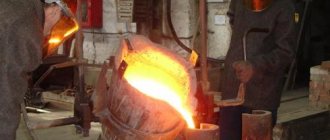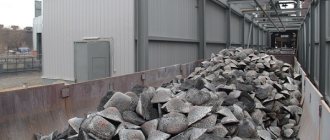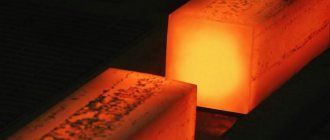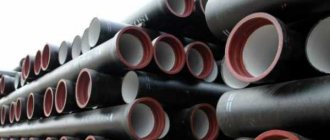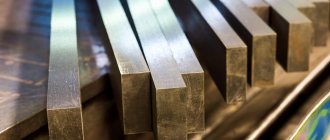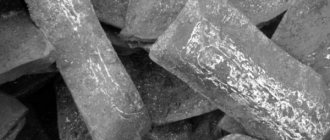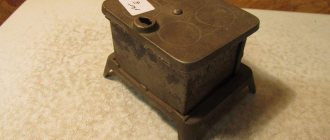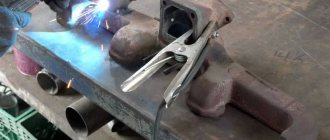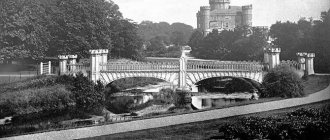Types of cast iron:
Depending on the form of carbon present in the alloys, white, gray, malleable and high-strength cast irons are distinguished.
- White cast iron - It received this name from the type of fracture, which has a matte white color. All carbon in this cast iron is in a bound state in the form of cementite. White cast irons have greater hardness (HB 450-550) and, as a result, they are very brittle and are not used for the manufacture of machine parts.
The high hardness of white cast iron ensures its wear resistance, including when exposed to aggressive environments. This property is taken into account when making piston rings from it. However, white cast iron is used mainly for casting parts on malleable cast iron, which is why it is called pig iron.
- Gray Cast Iron – In gray cast iron, the carbon is in the form of plate-shaped graphite. Gray cast iron is marked with a combination of the letters “C” - gray, “H” - cast iron and numbers that indicate tensile strength in MPa.
- High-strength cast iron – A distinctive feature of high-strength cast iron is its high mechanical properties, since the carbon structure in it is spheroidal graphite. This increases the strength of cast iron and makes it possible to obtain alloys with sufficiently high ductility and toughness.
The brand designation includes the letters “B” - high-strength, “H” - cast iron and numbers indicating tensile strength in MPa.
- Malleable cast iron – Malleable cast iron is a cast iron in which the graphite has a flake-like shape. Despite their name, they are never forged. The configuration of a ductile iron part is determined by the shape of the casting. Malleable cast iron is marked “K” - malleable, “C” - cast iron and with numbers.
The first group of numbers shows the tensile strength of cast iron, MPa:
The second is the relative elongation at break in %.
Production
The technology for the industrial extraction of iron from iron-containing raw materials and the production of cast iron is quite labor-intensive and complex. There is no point in describing all chemical and technological processes and delving into terminology. If you wish, you can study the issue in sources on metallurgy.
Cast iron is smelted from magnetic, red, and brown iron ore at metallurgical plants and in special blast furnaces. The fuel is coke, which can be partially replaced by fuel oil or gas.
The ore undergoes preliminary preparation before entering the blast furnace. In addition to ore and fuel, fluxes are used for smelting - limestones, which are necessary to form slag and remove sulfur from the melt.
Preparation methods depend on the quality of the ore - crushing, sorting, agglomeration, beneficiation and others.
After going through all the complex processes, the ore turns into a charge, which is continuously loaded into the blast furnace.
Through tuyeres in the lower part, hot air enriched with oxygen and natural gas are supplied, which burns under the influence of high temperatures, forming oxygen dioxide. Rising higher, the gas combines with oxygen and unburned carbon, transforming into carbon monoxide CO. It reacts with iron oxides, “taking” oxygen from them.
The result is an almost pure metal. The molten cast iron mass flows into the furnace. Non-combustible residues also flow down.
The finished cast iron is poured at certain intervals into special ladles.
While the smelting process is underway in the furnace, the hole through which the cast iron is released is plugged with a special plug made of a refractory mass. To release the metal, a hole is punched in the cork. Through special channels in the floor of the workshop, the flow of molten metal flows in a “red drain”.
Liquid slag is also discharged from the furnace through another channel.
A sample is taken from each melt. The metal is poured into a special mold and analyzed. All processes are automated. Operators are watching them.
To the average person, a blast furnace appears to be a giant test tube in which the “mystery” of turning iron ore into cast iron takes place.
Cast irons with special properties.
Depending on the purpose, wear-resistant, anti-friction, heat-resistant and corrosion-resistant cast irons are distinguished.
Wear-resistant (anti-friction) cast iron.
Designated by a combination of the letters AChS, AChK, AChV. The letters C, K, B indicate the type of cast iron: gray, malleable, high-strength. The number indicates the cast iron number.
Chromium, nickel, copper, and titanium are used to alloy antifriction cast irons
Heat-resistant and heat-resistant cast irons.
They are designated by a set of capital letters of the Russian alphabet and the letters following them. The letter "C" is cast iron. The letter “Ш” at the end of the mark means the spherical shape of graphite. The remaining letters indicate alloying elements, and the numbers following them correspond to their percentage content in the cast iron.
Heat-resistant cast irons are used for the manufacture of parts for contact devices of chemical equipment operating in gas environments at 0 temperatures of 900-1100 C.
Corrosion-resistant cast irons.
Corrosion-resistant cast irons are highly resistant to gas, air and alkaline environments. They are used for the manufacture of parts of friction units operating at elevated temperatures.
Examples of designation and decoding:
1. SCh15 – gray cast iron, tensile strength 150 MPa.
2. KCh45-7 – malleable cast iron, tensile strength 450 MPa, relative elongation 7%.
3. VCh70 – high-strength cast iron, tensile strength 700 MPa
4. AChV – 2 – anti-friction high-strength cast iron, number 2.
5. ChN20D2KhSh – heat-resistant high-alloy cast iron containing 20% nickel, 2% copper, 1% chromium, the rest is iron, carbon, graphite shape is spherical
6. ChS17 – corrosion-resistant silicon cast iron, containing 17% silicon, the rest is iron and carbon.
Definition :
Steel is an alloy of iron and carbon, containing no more than 2.14% carbon, as well as a number of other elements.
Classification:
To correctly read a brand, it is necessary to take into account its place in
classification of steel by chemical composition, purpose, quality, degree of deoxidation.
– Based on their chemical composition, steels are divided into carbon and alloy.
– Steels according to their intended purpose are divided into structural, tool and special-purpose steels with special properties.
– Steels are classified according to quality into ordinary quality steel, high quality steel, high quality steel and especially high quality steel.
– Classification according to the degree of deoxidation. Steels are classified according to the degree of deoxidation into calm, semi-quiet and boiling.
Table 1. – Classification of steels
| Steel by chemical composition | |||||
| Carbon | Alloyed | ||||
| low carbon (up to 0.25% C), medium carbon (0.25-0.6% C high carbon (more than 0.6% C) | low-alloy (with a total content of alloying elements up to 2.5%), medium alloyed (from 2.5 to 10%) and highly alloyed (over 10%). | ||||
| By purpose | |||||
| instrumental | structural | ||||
| By quality (content of harmful impurities) | |||||
| Ordinary quality contains up to 0.06% S and 0.07% P | Quality up to 0.035% S and 0.035% P | High quality no more than 0.025% S and 0.025% P | Particularly high quality no more than 0.015% S and 0.025% P | ||
Structural steels are steels intended for the manufacture of various parts, components of mechanisms and structures.
Tool steels are steels used for processing materials by cutting or pressing, as well as for the manufacture of measuring instruments.
Special steels are high-alloy steels (over 10%) that have special properties - corrosion resistance, heat resistance, heat resistance, wear resistance, etc.
Carbon steels
Carbon steels include steels that do not contain specially introduced alloying elements.
Structural carbon steels.
Carbon steels of ordinary quality (steel with a fairly high content of harmful impurities S and P) are designated according to GOST 380-94.
These most widespread steels are supplied in the form of rolled products in a normalized condition and are used in mechanical engineering, construction and other industries.
Carbon steels of ordinary quality are designated by the letters:
St and numbers from 0 to 6. The numbers are the conditional number of the brand. The higher the number, the higher the carbon content, higher the strength and lower the ductility.
Before the symbol St indicate a group of guaranteed properties: A, B, C. If there is no indication of a group, then group A is assumed.
For example , ST3; BSt4; VSt2.
Ordinary quality steel is also produced with a higher manganese content (0.8-1.1% Mn) / In this case, the letter G is added after the grade number. For example, BST3Gps.
After the steel grade number, the degree of deoxidation is indicated: kp - boiling , ps - semi-quiet , sp - calm steel .
For example, VSt3ps.
Table 2. – Designation structure for carbon steels.
Steel group | Designation | Steel number | Degree of deoxidation | Category |
| A | St | 0 | – | 1, 2, 3 |
| 1, 2, 3, 4 | kp, ps, sp | |||
| 5, 6 | ps, sp | |||
| B | BSt | 1, 2, 3, 4 | kp, ps, sp | 1, 2 |
| 5, 6 | ps, sp | |||
| IN | VSt | 1, 2, 3, 4 | kp, ps, sp | 1, 2, 3, 4, 5 |
| 5 | ps, sp |
Table 3. – Meaning of letters and numbers used when marking steels of ordinary quality.
| Designation | Explanation of the designation |
| A | A group of steels supplied with guaranteed mechanical properties. Usually, when designating steels, the letter A is omitted. |
| B | A group of steels supplied with a guaranteed chemical composition. |
| IN | A group of steels supplied with guaranteed chemical and mechanical properties. |
| St | Abbreviation for the term "steel" |
| 0 – 6 | Conventional steel grades. |
| G | The presence of the letter G after the steel number means a high manganese content. |
| KP | “Boiling” steel, deoxidized only by ferromanganese. |
| Ps | “Semi-quiet” steel, deoxidized with ferromanganese and aluminum. |
| Sp | The steel is “calm”, that is, completely deoxidized. |
Examples of designation and decoding:
- BST2kp – structural carbon steel of ordinary quality, group B, supplied with a guaranteed chemical composition, number 2, boiling.
- ST5Gps – structural steel of ordinary quality, group, supplied with guaranteed mechanical properties, number 5, manganese content up to 1%, semi-quiet.
- VSt3sp – structural carbon steel of ordinary quality, group B, supplied with a guaranteed chemical composition and mechanical properties, number 3, quiet.
Areas of use
There are many areas of application of cast iron. This situation has arisen due to the various types and classifications of this metal. This:
- Heavy industry (production of parts and various items in metallurgy and machine tool building).
- Mechanical engineering (gray cast iron is usually used, as it has useful properties - resistance to vibrations and vibrations).
- Automotive industry (both metal is used in its pure form and mixed with graphite for the manufacture of cylinders, crankshafts and other elements).
- Brake pads used in various spheres of life (flour-grinding industry, paper-making industry).
- For the production of household and household utensils - cauldrons, frying pans, pots and other utensils (does not cause allergic reactions, retains heat well and does not oxidize).
- In art (these are forged and cast fences, gates, monuments and decorative items).
- In the oil industry (pipes and other products made of cast iron in this industry are characterized by durability and excellent performance properties).
- For the manufacture of bathtubs and sinks (service life more than 50-60 years).
The production of cast iron is carried out exclusively on the basis of special technical instructions, which specify the properties, grades and characteristics.
Today there is almost no area of human life where cast iron is not used. This material has been known to mankind for quite a long time and has proven itself excellently from a practical point of view. Cast iron is the basis for a great variety of parts, assemblies and mechanisms, and in some cases even a self-sufficient product capable of performing the functions assigned to it. Therefore, in this article we will pay close attention to this iron-containing compound. We will also find out what types of cast iron there are, their physical and chemical characteristics.
Read also: Manual riveter for blind rivets
Designation of carbon quality structural steels
High-quality structural steel is steel with a noticeably lower content of sulfur, phosphorus and other harmful impurities. Designated according to GOST 1050-88.
Steel is marked with two-digit numbers, which indicate the carbon content in hundredths of a percent, and is supplied with guaranteed chemical composition and mechanical properties. According to the degree of deoxidation, steel is divided into boiling (kp), semi-quiet (ps), calm (without indicating an index). The letter G in steel grades indicates a high manganese content (up to 1%).
Examples of designation and decoding
- Steel 05kp – low-carbon structural steel, high-quality, containing 0.05% carbon, boiling.
- Steel 25 – low-carbon structural steel, high-quality carbon containing 0.25%, calm.
- Steel 60G – medium-carbon structural steel, high-quality, containing 0.6% carbon, 1% argan, calm.
Automatic steels
Designation of automatic steels
According to GOST 1414-75, these steels are marked with the letter A and numbers indicating the average carbon content in hundredths of a percent. The following grades of automatic steel are used: A12, A20, AZO, A40G.
Non-critical parts are prepared from A12 steel, and more critical parts that operate under significant stresses and elevated pressures are made from steel of other grades. The range of free-cut steel includes the production of long products in the form of bars of round, square and hexagonal sections. These steels are not used for the manufacture of welded structures.
Examples of designation and interpretation
AS12ХН – automatic alloy steel, low-carbon, containing 0.12% carbon, 1% chromium and nickel.
Boiler rooms steel.
Sheet steel for boilers and pressure vessels is used for the manufacture of steam boilers, ship furnaces,
combustion chambers of gas turbines and other parts. They must operate at variable pressures and temperatures up to 450″C. In addition, boiler steel must be weldable well. To obtain such properties, a technological additive (titanium) is introduced into carbon steel and additionally deoxidized with aluminum. The following grades of carbon boiler steel are produced: 12K, 15K, 16K, 18K.20K.22K with a carbon content of 0.08 to 0.28%.
These steels are supplied in the form of sheets with a thickness of up to 200 mm and forgings in the condition after normalization and tempering.
Tool carbon steels.
Designation of carbon tool steels
Tool carbon steels are marked in accordance with GOST 1435-90.
Tool carbon steels are produced in the following grades:
U7.U8GA.U8G, U9, U 10, U 11, U 12 and U 13. The numbers indicate the carbon content in tenths of a percent. The letter G after the number means that the steel has a high manganese content. The grade of high quality tool carbon steel has the letter A.
Examples of designation and decoding
- U12 – tool steel, high-carbon, containing 1.2% carbon, high-quality.
- U8GA – tool steel, high-carbon, containing 0.8% carbon, 1% manganese, high quality.
- 3 . U9A – tool steel, high-carbon, containing 0.9% carbon, high-quality.
Alloy steels.
Alloyed steel is steel with one or more alloying elements specially introduced.
Designation of alloy steels
Alloy steels are marked with a combination of numbers and capital letters of the alphabet. The designation does not contain the word “steel” or the symbol “St”. For example, 40Х, 38ХМ10А, 20Х13. The first two digits indicate the carbon content in hundredths of a percent. The following letters are abbreviations for the element. The numbers after the letters indicate the content of this element in whole percentages. If there is no number behind the letter, then the content of this element is up to 1%.
Table 4. – Designation of brand elements.
| Yu-AI Aluminum | C-Si Silicon | AN Nitrogen |
| R-V Bor | G-Mn Manganese | D – Cu Copper |
| F-V Vanadium | M-Mo Molybdenum | E-Se Selenium |
| B-W Tungsten | N-Ni Nickel | C-Zr Zirconium |
| F-Fe Iron | T-Ti Titan | B-Nb Niobium |
| K-Co Cobalt | Ta – Tantalum | X-chrome |
X, HVG are used for the manufacture of measuring instruments.
Steels for dies: 9Х, Х12М, 3Х2Н8Ф.
Steels for impact tools: 4ХС, 5ХВ2С.
Designation of high-speed steels
All high speed steels are high alloy. These are steels for equipping the working part of cutters, cutters, drills, etc.
The marking of high-speed steels always begins with the letter P and a number indicating the tungsten content as a percentage. The most common brands are P9, P18, P12.
Other indicators
As for the division of cast iron by strength, the following classification is used:
- Normal strength: σв up to 20 kg/mm 2.
- Increased strength: σв = 20 - 38 kg/mm 2.
- High strength: σв = 40 kg/mm 2 and higher.
Based on ductility, cast irons are divided into:
- Non-plastic - relative elongation less than 1%.
- Low plasticity – from 1% to 5%.
- Plastic - from 5% to 10%.
- Increased ductility – more than 10%.
In conclusion, I would also like to be sure to note that even the shape and nature of the pouring has a fairly significant influence on the properties of any cast iron.
Areas of use of the material
Mechanical properties and chemical composition of cast iron.
The use of malleable cast iron was found in mechanical engineering, automotive industry, in the production of railway cars, and in the manufacture of agricultural equipment.
The best properties for the noted applications are the pearlite type. However, despite the higher characteristics, black-heart alloy is more often used. This is due to lower production costs.
Only for the manufacture of parts subject to high loads, white-core material is used. Such products include springs, engine parts, etc.
